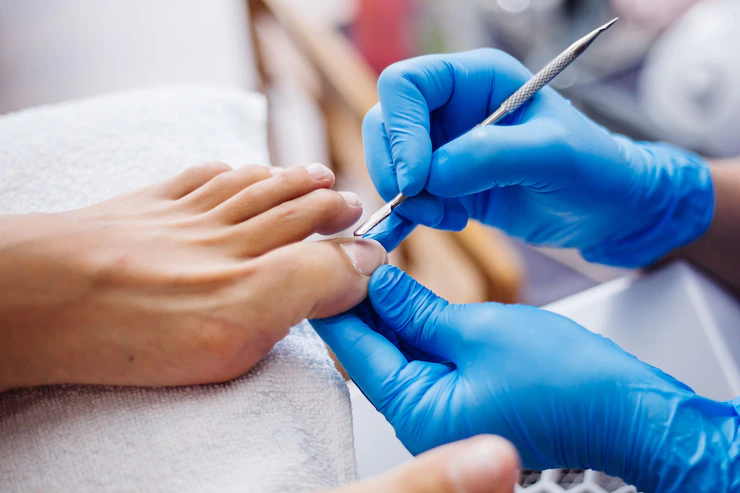
Ingrown toenails and fungal infections can cause discomfort and pain. In cases where conservative treatments fail to provide relief, toenail surgery might be considered. This comprehensive guide will delve into everything you need to know about toenail surgery – from reasons for surgery to recovery and aftercare.
Table of Contents
Understanding Toenail Problems
Toenail problems encompass diverse challenges that can disrupt comfort, mobility, and overall well-being. Below are the primary concerns that often warrant surgical intervention:
1. Ingrown Toenails
Ingrown toenails stand as a prevalent issue that can induce considerable discomfort. This condition arises when the edge of the toenail grows into the neighboring skin, resulting in pain, inflammation, and occasionally infection.
With that, ingrown toenail surgery becomes a viable solution when conventional remedies prove ineffective, providing targeted relief by addressing the root cause of the ingrown nail and facilitating optimal healing.
2. Fungal Infections
Fungal infections can wreak havoc on toenail health, leading to unsightly discoloration, pronounced thickening, and the disintegration of the nail structure.
In severe cases where the infection proves resilient to traditional treatments like antifungal medications, toenail surgery emerges as a potential option. Surgical removal of the affected nail allows for the thorough elimination of the fungal presence and provides a fresh canvas for the growth of a healthier nail.
3. Trauma or Injury
Accidents and injuries can inflict significant harm upon toenails. A heavy object falling on the toe or sudden trauma can substantially damage the nail structure.
Toenail surgery ensures proper removal of the damaged tissue, laying the groundwork for regenerating a new nail and reducing the risk of complications.
4. Chronic Pain and Deformities
Toenail deformities, including excessive curvature or abnormal thickness, can give rise to chronic pain and discomfort. These deformities can stem from various factors, including genetic predisposition.
In scenarios where non-surgical treatments prove inadequate in alleviating the discomfort, toenail surgery offers a targeted approach to address the deformity, rectify the underlying issue, and restore comfort and functionality.
When Is Toenail Surgery Necessary?
Toenail surgery is typically considered when other conservative treatments like proper nail trimming, antibiotics, antifungal medications, and soaking fail to provide relief. A qualified podiatrist or foot specialist will evaluate the condition and recommend surgery if it is deemed the best course of action.
Types of Toenail Surgery
Toenail surgery encompasses various procedures, each tailored to target specific nail-related issues. Whether addressing ingrown nails, chronic infections, or traumatic damage, these surgeries offer effective solutions. Here are the various types of toenail surgery, shedding light on their purposes and applications:
1. Partial Nail Removal (Partial Matrixectomy)
Partial nail removal, known as partial matrixectomy, is commonly employed to tackle the vexing problem of ingrown toenails. This surgery entails carefully removing the nail or nail matrix section contributing to the issue. The matrix, responsible for nail growth, might be meticulously trimmed to rectify the ingrown aspect of the nail.
2. Total Nail Removal (Total Matrixectomy)
For those grappling with the stubborn grip of chronic infections, deeply ingrained ingrown nails, or unyielding fungal infections, total nail removal emerges as a comprehensive recourse. This surgery takes a bold step by extracting the entire nail and its matrix.
3. Nail Avulsion
Traumatic injuries can harshly blow to toenails, leaving them irreparably damaged. Nail avulsion strides in as the solution of choice in such scenarios. This procedure involves the strategic removal of a portion or the entirety of the nail plate.
The Toenail Surgery Procedure
Toenail surgery is usually performed in an outpatient setting. Depending on the type of surgery, local anesthesia is administered to numb the toe, ensuring the procedure is painless. The surgeon will then carefully perform the necessary steps based on the specific condition and type of surgery.
Recovery and Aftercare
Following toenail surgery, the recovery and aftercare process is of utmost importance to ensure optimal healing and prevent potential complications. Here’s a detailed breakdown of the key steps to take during your recovery journey:
1. Dressing and Bandaging
This protective covering serves a dual purpose – safeguarding the wound from external contaminants and providing an environment conducive to efficient healing. Proper dressing and bandaging also help to prevent infection and maintain the integrity of the surgical site.
2. Pain Management
It’s common to experience pain and discomfort in the initial stages of recovery after toenail surgery. However, effective pain management strategies are available to alleviate these sensations. Your doctor may recommend over-the-counter pain relievers specifically tailored to your needs. Adhering to your physician’s guidance ensures you remain comfortable during this crucial healing phase.
3. Foot Elevation
Elevating the treated foot is a simple yet effective technique for reducing post-operative swelling and enhancing blood circulation. When resting, positioning your foot slightly above heart level encourages blood flow away from the surgical area. This helps to mitigate inflammation and promote the delivery of vital nutrients and oxygen to the healing tissues.
4. Restricted Activities
During the initial stages of healing, it’s imperative to exercise caution and refrain from engaging in strenuous activities that could exert undue pressure on the healing toe. Activities such as vigorous exercise, heavy lifting, or prolonged standing should be avoided, as they could potentially disrupt the healing process or lead to complications.
5. Follow-Up
Regular and consistent follow-up appointments with your podiatrist are a cornerstone of successful toenail surgery recovery. These appointments serve as opportunities for your healthcare provider to monitor your progress, assess the healing of the surgical site, and address any concerns that may arise.
A Solution for Persistent Problems
Toenail surgery is a viable option for individuals suffering from persistent toenail problems that haven’t responded to conservative treatments. If you’re experiencing chronic toenail issues, consulting a qualified podiatrist is the first step toward finding the most appropriate solution and restoring your foot health.















